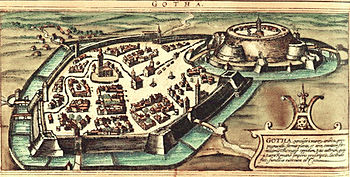|
Grumbach Feud
The “Grumbach Feud” (German: Grumbachsche Händel), in 1567, was a rather bizarre episode in the history of the Ernestine side of the House of Wettin, which led to life imprisonment for Elector John Frederick II “the Middle”, the Duke of Saxe-Coburg-Eisenach. History Because of the Treaty of Leipzig in 1485, the House of Wettin was divided into two sides, the Ernestine line and the Albertine line (Leipziger Teilung or “Leipziger Division”). At first, the Electorate of Saxony remained in the older of the two lines, the Ernestine. However, in 1547, Elector John Frederick I “the Magnanimous” lost the Battle of Mühlberg and therefore the Schmalkaldic War against the Holy Roman Emperor, Charles V, and had to agree to the Wittenberger Capitulation, which erased his rank of Elector and transferred the Electorate, including Wittenberg, to the Albertine side. When John Frederick “the Magnanimous” died in 1554, he was succeeded by his three sons, John Frederick II “the Middle”, John William and John Frederick III, “the Younger”. They tried to rule together but, in 1565, after the death of John Frederick III, the surviving elder brothers agreed to the division of their lands. John Frederick II got Coburg and Eisenach while Weimar went to John William. John Frederick II took up his residence in Gotha. He continued to pursue his late father’s claims on the Electorate for himself. His friend, a Ritter named Wilhelm von Grumbach, took it up for him, as the Duke was still under the Imperial ban for the breach of the peace. Grumbach encouraged the Duke with a daring plan, which involved an uprising of the German knights, the assistance from King Frederick II of Denmark, and the use of magic charms. For good measure, the Engelseher (“Angel Seer”) Hans Tausendschön claimed that an angel had appeared to him and predicted the resurrection and ascendance of the Ernestine family. This, Grumbach promised that he would achieve without a military confrontation, thus giving the Ernestines the electoral dignity again.  But in 1563 the Ritter raised an army and attacked Würzburg, which he seized and plundered. He was consequently placed under the Imperial ban but John Frederick II refused to obey the order of Emperor Maximilian II to turn him over to the Imperial authorities. Maximilian then postponed the case to the next Reichstag, to be held in 1566 in Augsburg, giving Grumbach the time to plot the assassination of his patron’s cousin and rival, Augustus, Elector of Saxony, from the Albertine side. Proclamations were issued to call for assistance and alliances inside and outside the Holy Roman Empire were made. But, in March 1566, at the Augsburg Diet, the Lutheran estates of the former Schmalkaldic League and even John Frederick’s own brother, John William, sided with Maximilian. On 13 May 1566, the Reichsexekution was imposed, with the signature of the Emperor, upon John Frederick. Elector Augustus of Saxony was entrusted to carry it out. This he did, by laying siege to the city of Gotha and the Grimmenstein Castle. He did not get any help from his allies. But he still managed to incite a mutiny among the defenders and both the city and the castle fell. Ultimately John Frederick II had to surrender and enter Imperial captivity in Austria, where he died 29 years later. Grumbach was executed with dismemberment on 18 April 1567 in the marketplace of Gotha. Thereafter, Elector Augustus had his mint in Dresden to make a commemorative taler (Gedenktaler) with the Gotha imprint, with an ostentatiously large obverse and the Latin inscription: 
AftermathThe lands of John Frederick “the Middle” were first handed over to his brother John William for the management. In 1572, the two sons of John Frederick II, John Casimir (1564–1633) and John Ernest (1566–1638) were restored to the possessions of their father. But they still had to share them with their uncle John William, according to the terms of the Erfurter Division (Erfurter Teilung) Treaty. This was the first of the several subdivisions of the properties of the Ernestines in Thuringia, through which the Thuringian mini-states, the Ernestine duchies, eventually emerged. The Grumbach Feud is regarded as the last breach of the Ewiger Landfriede. Bibliography
References
|